
152
6–1a: Arpeggio Select, , Pattern, Length, Octave,
Resolution, Sort, Latch, Key Sync., Keyboard
Arpeggio Select [A, B]
If you have moved here from Combination, Sequencer or
Song Play mode and edit an arpeggio pattern, you must
select either arpeggiator A or B as the pattern to edit. Your
editing will apply only to the selected one. B will not be dis-
played if you moved here from Program mode.
(Tempo) [040...240, EXT]
Specifies the tempo.
This can also be adjusted by the ARPEGGIATOR [TEMPO]
knob. If “MIDI Clock” (1–1a) is set to External MIDI or
External mLAN, this will indicate EXT, and the arpeggiator
will synchronize to MIDI Clock messages from an external
MIDI device.
Pattern [P000...P004, U000(I–A/B)...U506(User)]
Selects the pattern that you want to edit.
If you want to edit an arpeggio pattern (such as a pre-
loaded arpeggio pattern) that is also used by another
program, it is a good idea to use the page menu com-
mand “Copy Arpeggio Pattern” to copy the arpeggio
pattern to an unused number U312 (User)–U506 (User),
and then to edit the copy. Also, U200 (E–A)–U311 (E–G)
are normally used to load arpeggio patterns for the
EXB-PCM series options (some models do not include
arpeggio patterns).
If you want to edit the arpeggio pattern name, execute
the page menu command “Rename Arpeggio Pattern.”
Length (Pattern Length) [01...48]
Specifies the length of the arpeggio pattern. The arpeggio
pattern will play the number of steps you specify here at the
note value interval specified by “Resolution,” and will then
begin again. This is not valid for preset arpeggio patterns
P000–P004.
Octave [1, 2, 3, 4]
Resolution [ , , , , , ]
Sort [Off, On]
Latch [Off, On]
Key Sync. [Off, On]
Keyboard [Off, On]
☞Program P7 “7–1: Arpeg. Setup.”
“Pattern,” “ (Tempo),” “Octave,” “Resolution,” “Sort,”
“Latch,” “Key Sync,” and “Keyboard” are parameters
that can be set in Program, Combination, Song, and
Song Play modes, but you can also set them here.
If you move here from Program or Combination mode
and set these parameters, you must return to the origi-
nal mode and write them. These parameters cannot be
written by the “Write Arpeggio Patterns” command in
this page.
6–1b: Arpeggio Pattern Setup
These parameters are not valid for preset patterns
P000–P004.
Arpeggio Tone Mode [Normal, Fixed Note]
This selects the Tone type of the arpeggio pattern.
Normal: This is the conventional arpeggiator type. Each
Tone in the arpeggio will be the pitch of the note number
that you are pressing on the keyboard.
Fixed Note: The note number of each tone will be fixed. The
note numbers played on the keyboard will be ignored, and
the arpeggio will sound using the pitches you specify for the
Tones. Note numbers from the keyboard will only control
the trigger timing of the arpeggiator. Fixed Note mode is
ideal for arpeggio patterns that you are using as drum pat-
terns.
In the P6: User Arpeggio, Pattern Edit page, the Tone indica-
tors will be “●” when Normal is selected here, or “❍” when
Fixed Note is selected.
Arpeggio Type [As Played...Up&Down]
Specifies the relationship between the arpeggio notes speci-
fied from the keyboard and the Tone at each step.
As Played: If there are more Tones in a step than arpeggio
notes specified (notes played on the keyboard), those steps
will not sound.
As Played (Fill): If there are more Tones in a step than
arpeggio notes specified (notes played on the keyboard), the
last arpeggio note (the last-played note if “Sort” is Off, or
the highest note if “Sort” is On) will sound for those steps.
Running Up: If there are more Tones in a step than arpeggio
notes specified (notes played on the keyboard), the arpeggio
will return to the first note (the first-pressed note if “Sort” is
Off, or the lowest note is “Sort” is On) and sound it.
Up&Down: If there are more Tones in a step than arpeggio
notes specified (notes played on the keyboard), the arpeggio
will return in reverse direction from the last arpeggio note
back toward the first.
Example)
If you set “Length” to 04, “Step No.” 01 to Tone0, “Step
No.” 02 to Tone1,” “Step No.” 03 to Tone2, “Step No.” 04
to Tone3, and simultaneously play three notes to produce
an arpeggio, the following results will be produced
depending on the “Arpeggio Type.”
As Played: 0 → 1 → 2 → rest → 0 → 1 → 2 → rest → 0 ...
As Played (Fill): 0 → 1 → 2 → 2 → 0 → 1 → 2 → 2 → 0 ...
Running Up: 0 → 1 → 2 → 0 → 0 → 1 → 2 → 0 → 0 ...
Up&Down: 0 → 1 → 2 → 1 → 0 → 1 → 2 → 1 → 0 ...
Octave Motion [Up, Down, Both, Parallel]
Specifies the operation when “Octave” is set to 2–4 octaves.
Up: Notes will repeatedly ascend within the specified range
of octaves.
Down: Notes will repeatedly descend within the specified
number of octaves.
Both: Notes will repeatedly ascend and descend within the
specified number of octaves.
Parallel: The notes of the specified octaves will sound simul-
taneously.
Fixed Note Mode [Trigger As Played, Trigger All Tones]
When the “Arpeggio Tone Mode” is Fixed Note, specify the
condition that will trigger the Tones.
Trigger As Played: The Tones will be triggered according to
the number of keys pressed.
Trigger All Tones: Pressing a single key will trigger all
Tones.
P000...P004 Preset arpeggio patterns
U000(I-A/B)...U199(I-A/B) Preloaded arpeggio patterns
U200(E-A)...U215(E-A)
U216(E-B)...U231(E-B)
U232(E-C)...U247(E-C)
U248(E-D)...U263(E-D)
U264(E-E)...U279(E-E)
U280(E-F)...U295(E-F)
U296(E-G)...U311(E-G)
EXB-PCM series arpeggio patterns
U312(User)...U506(User) User arpeggio patterns (some pre-
loaded arpeggio patterns)


















